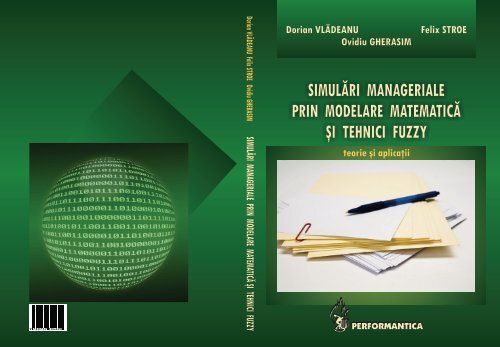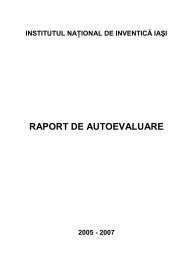simulări manageriale prin modelare matematică şi tehnici fuzzy
simulări manageriale prin modelare matematică şi tehnici fuzzy
simulări manageriale prin modelare matematică şi tehnici fuzzy
You also want an ePaper? Increase the reach of your titles
YUMPU automatically turns print PDFs into web optimized ePapers that Google loves.
9 789737 304698<br />
Dorian VLĂDEANU Felix STROE Ovidiu GHERASIM SIMULĂRI MANAGERIALE PRIN MODELARE MATEMATICĂ ŞI TEHNICI FUZZY<br />
Dorian VLĂDEANU Felix STROE<br />
Ovidiu GHERASIM<br />
SIMULĂRI MANAGERIALE<br />
PRIN MODELARE MATEMATICĂ<br />
ŞI TEHNICI FUZZY<br />
teorie <strong>şi</strong> aplicaţii
Dorian VLĂDEANU<br />
Felix STROE<br />
Ovidiu GHERASIM<br />
SIMULĂRI MANAGERIALE<br />
PRIN MODELARE MATEMATICĂ<br />
ŞI TEHNICI FUZZY<br />
Teorie <strong>şi</strong> aplicaţii<br />
PERFORMANTICA<br />
Ia<strong>şi</strong> – 2008
Editura PERFORMANTICA<br />
Institutul Naţional de Inventică, Ia<strong>şi</strong><br />
performantica@inventica.org.ro<br />
Ia<strong>şi</strong>, Bd. Carol I nr. 3-5<br />
tel/fax: 0232-214763<br />
Descrierea CIP a Bibliotecii Naţionale a României<br />
VLĂDEANU, Dorian<br />
Simulări <strong>manageriale</strong> <strong>prin</strong> <strong>modelare</strong> <strong>matematică</strong><br />
<strong>şi</strong> <strong>tehnici</strong> <strong>fuzzy</strong> /<br />
Dorian VLĂDEANU, Felix STROE, Ovidiu GHERASIM<br />
– Ia<strong>şi</strong>: Performantica, 2008<br />
ISBN: 978-973-730-469-8<br />
1. Felix STROE,<br />
2. Ovidiu GHERASIM<br />
Referenţi ştiinţifici:<br />
Prof univ. dr. Emilian M. DOBRESCU<br />
Prof. univ. dr. Ioan RADU<br />
Consilier editorial:<br />
prof. dr. Traian Stănciulescu<br />
Secretar de redacţie:<br />
Octav Păuneţ<br />
Coperta:<br />
Carmen Anton<br />
EDITURĂ ACREDITATĂ DE CNCSIS BUCUREŞTI, 1142/30.06.2003<br />
Copyright © 2008<br />
Toate drepturile asupra acestei ediţii sunt rezervate autorilor
SIMULĂRI MANAGERIALE PRIN<br />
MODELARE MATEMATICĂ ŞI TEHNICI FUZZY
CUPRINS<br />
Cap. I. BAZELE TEORETICE ALE SIMULĂRILOR<br />
MANAGERIALE 13<br />
1.1. NoŃiuni introductive 13<br />
1.2. Concepte, definiŃii, noŃiuni de bază 15<br />
1.3. Clasificarea <strong>tehnici</strong>lor de simulare 24<br />
1.4. Bazele teoretice ale <strong>simulări</strong>lor <strong>fuzzy</strong> 29<br />
1.4.1. Introducere 29<br />
1.4.2. MulŃimea numerelor <strong>fuzzy</strong> 31<br />
1.4.3. MulŃimea numerelor <strong>fuzzy</strong> elementare Fe<br />
1.4.4. Aritmetica numerelor <strong>fuzzy</strong> elementare 43<br />
1.4.5. RelaŃia de ordine între numerele <strong>fuzzy</strong> 45<br />
1.4.6. FuncŃii elementare de variabilă număr <strong>fuzzy</strong> 48<br />
1.4.7. NoŃiuni de topologie pe spaŃiului numerelor <strong>fuzzy</strong> 52<br />
1.4.8. Derivate <strong>şi</strong> primitive ale funcŃiilor <strong>fuzzy</strong> 55<br />
1.5. Etapele procedurilor de simulare 63<br />
1.6. Problematica limbajelor de simulare 74<br />
1.7. Alte aspecte ale procedurilor de simulare 97<br />
Cap. II. PROBLEME ECONOMICE DE BAZĂ COMPATIBILE CU<br />
PROCEDURILE DE SIMULARE 111<br />
2.1. Problema gradului de detaliere a procesului decizional 111<br />
2.2. Simularea proceselor de servire 113<br />
2.2.1. Simularea proceselor de servire monocanal 115<br />
3.2.2. Simularea proceselor de servire în cascadă (paralel) 122<br />
2.3. Simularea probabilităŃilor de producere a unor evenimente în<br />
interacŃiune cu alte evenimente 125<br />
2.4. Simularea strategiilor de conducere <strong>şi</strong> organizare în funcŃie de stările<br />
previzibile ale sistemului 128<br />
2.5. Simularea sistemelor de producŃie 132<br />
2.5.1. Simularea sistemelor de producŃie simple <strong>şi</strong> ireductibile 132<br />
2.5.2. Simularea sistemelor de producŃie complexe 147<br />
2.5.3. Simularea sistemelor socio-productive cu entropie 152<br />
39
4<br />
Dorian VLĂDEANU, Felix STROE, Ovidiu GHERASIM<br />
Cap. III. APLICAłII ALE SIMULĂRILOR MANAGERIALE 165<br />
3.1. Determinarea <strong>şi</strong> simularea influenŃei nivelului <strong>şi</strong> structurii producŃiei<br />
asupra costurilor totale 165<br />
3.1.1. GeneralităŃi 165<br />
3.1.2. Determinarea tipului de funcŃie pentru<br />
<strong>modelare</strong>a dependenŃei cost-structură a producŃiei 166<br />
3.1.3. Determinarea dependenŃelor cost total-structură a producŃiei 168<br />
3.1.4. Concluzii 172<br />
3.2. Identificarea scenariilor de evoluŃie compatibile cu stare economică<br />
dată pentru o zonă geografică 173<br />
3.2.1. Caracterizarea stării economico-sociale 173<br />
3.2.2. Identificarea, analiza <strong>şi</strong> corectarea modelului 178<br />
3.3. Simularea proceselor de producŃie <strong>şi</strong> comerciale 186<br />
3.3.1. Desfăşurarea <strong>simulări</strong>i <strong>manageriale</strong> 186<br />
3.3.2. SpecificităŃi ale pieŃei de distribuŃie 186<br />
3.3.3. Mecanismul decizional 188<br />
3.3.4. Rolul managerului general 192<br />
3.3.5. Rolul concis al managerului financiar 193<br />
3.3.6. Rolul managerului comercial 194<br />
3.3.7. Rolul managerului de producŃie 195<br />
3.4. Simularea proceselor de aprovizionare 197<br />
3.4.1. Modelul decizional 197<br />
3.4.2. RelaŃii în cadrul lanŃului de furnizare 198<br />
3.4.3. Definirea factorilor de concurenŃă 201<br />
3.4.4. PiaŃa externă 202<br />
3.4.5. Derularea procesului decizional 202<br />
3.4.6. Analiza indicatorilor de performanŃă 205<br />
3.5. Simularea comportamentului firmei 211<br />
3.5.1. Prezentare succintă a <strong>simulări</strong>i decizionale 211<br />
3.5.2. Principalele decizii strategice adoptate 212<br />
3.5.3. Evaluarea rezultatelor economice 217<br />
3.5.4. Dezbaterea unor probleme referitoare la activitatea curentă a societăŃii 221<br />
3.6. Simularea proceselor <strong>şi</strong> fenomenelor economice cu lanŃuri Markov cu<br />
extrem variabil <strong>şi</strong> metoda sistemelor cu entropie 229<br />
3.6.1. ConsideraŃii introductive 229<br />
3.6.2. Simularea <strong>şi</strong> prognoza sistemelor socio-productive cu entropie 230<br />
3.6.3. Prognoza <strong>şi</strong> simularea cu ajutorul lanŃurilor MARKOV <strong>şi</strong> maxim<br />
logistic 237<br />
3.6.4. Prognoza veniturilor sectoarelor economice <strong>prin</strong>cipale din raza<br />
municipiului “NE” 241<br />
3.6.5. Prognoza veniturilor la bugetul primăriei 246<br />
3.7. Simularea <strong>prin</strong> utilizarea <strong>tehnici</strong>lor <strong>fuzzy</strong> 257<br />
3.7.1. MulŃimea numerelor <strong>fuzzy</strong> dreptunghiulare F 258<br />
3.7.2. Algoritmul <strong>fuzzy</strong> de simulare cu lanŃuri MARKOV 260<br />
3.7.3. Exemple de aplicare a algoritmului <strong>fuzzy</strong> de simulare 264
Simulări <strong>manageriale</strong> <strong>prin</strong> <strong>modelare</strong> <strong>matematică</strong> <strong>şi</strong> <strong>tehnici</strong> <strong>fuzzy</strong> 5<br />
Cap. IV. ANALIZA, PROIECTAREA ŞI SIMULAREA<br />
STRATEGIILOR DE DEZVOLTARE pentru un operator de<br />
servicii de alimentare cu apă <strong>şi</strong> de canalizare nou înfiinŃat 279<br />
4.1. Analiza nucleului iniŃial integral (NII) 279<br />
4.1.1. PiaŃa N.I.I. 279<br />
4.1.2. Starea financiară a N.I.I. 286<br />
4.1.3. Starea economică a N.I.I. 297<br />
4.1.4. Starea tehnică 301<br />
4.1.5. Ierarhizarea globală 303<br />
4.2. Definirea obiectivelor investiŃionale <strong>şi</strong> proiectarea fluxurilor financiare 307<br />
4.2.1. Principalele acŃiuni ale unui program investiŃional 307<br />
4.2.2. Fundamentarea prognozelor pentru serviciul de alimentare cu apă<br />
<strong>şi</strong> de canalizare 309<br />
4.2.3. Proiectarea fluxurilor financiare (CASH–FLOW) 339<br />
4.2.4. Prognoza fluxurilor financiare (CASH–FLOW) 346<br />
Cap. V. CONCLUZII 351<br />
Anexe 355<br />
Bibliografie 380
CONTENTS<br />
Chap. I. THE THEORETICAL BASES OF MANAGERIAL<br />
SIMULATIONS 13<br />
1.1. Introductory notions 13<br />
1.2. Concepts, definitions, basic elements 15<br />
1.3. Classification of simulation techniques 24<br />
1.4. Theoretical bases of <strong>fuzzy</strong> simulations 29<br />
1.4.1. Introduction 29<br />
1.4.2. The set of <strong>fuzzy</strong> numbers 31<br />
1.4.3. The Fe set of elementary <strong>fuzzy</strong> numbers 39<br />
1.4.4. Arithmetic with elementary <strong>fuzzy</strong> numbers 43<br />
1.4.5. Order relation between <strong>fuzzy</strong> numbers 45<br />
1.4.6. Elementary functions of <strong>fuzzy</strong> number variable 48<br />
1.4.7. Notions of topology on the space of <strong>fuzzy</strong> numbers 52<br />
1.4.8. Derivates and primitives of <strong>fuzzy</strong> functions 55<br />
1.5. Steps of simulations procedures 63<br />
1.6. The problems of simulation languages 74<br />
1.7. Other aspects of simulation procedures 97<br />
Chap. II. BASIC ECONOMIC PROBLEMS COMPATIBLE WITH<br />
SIMULATION PROCEDURES 111<br />
2.1. The problem of detailing degree of decision-making process 111<br />
2.2. Simulation of serving processes 113<br />
2.2.1. Simulation of mono-channel serving processes 115<br />
3.2.2. Simulation of cascade-type (parallel) serving processes 122<br />
2.3. Simulation of the probabilities of some events to occur in interaction<br />
with others 125<br />
2.4. Simulation of organizing and leadership strategies depending on the<br />
anticipated states of the system 128<br />
2.5. Simulation of production systems 132<br />
2.5.1. Simulation of simple and irreducible production systems 132<br />
2.5.2. Simulation of complex production systems 147<br />
2.5.3. Simulation of socio-productive systems with entropy 152
Simulări <strong>manageriale</strong> <strong>prin</strong> <strong>modelare</strong> <strong>matematică</strong> <strong>şi</strong> <strong>tehnici</strong> <strong>fuzzy</strong> 7<br />
Chap. III. APPLICATIONS OF MANAGERIAL<br />
SIMULATIONS 165<br />
3.1. Determination and simulation of the influence of the production level<br />
and structure on total costs 165<br />
3.1.1. General ideas 165<br />
3.1.2. Determination of the type of function for the modelling of production<br />
cost-structure dependence 166<br />
3.1.3. Determination of production total cost-structure dependences 168<br />
3.1.4. Conclusions 172<br />
3.2. Identification of evolution scenarios compatible with the economic<br />
state of a given geographical area 173<br />
3.2.1. Characterzation of socio-economic state 173<br />
3.2.2. Identification analysis and correction of the model 178<br />
3.3. Simulation of production and commercial processes 186<br />
3.3.1. Development of managerial simulation 186<br />
3.3.2. Specificities of distribution market 186<br />
3.3.3. Decision-making mechanism 188<br />
3.3.4. Role of general manager 192<br />
3.3.5. Concise role of financial manager 193<br />
3.3.6. Role of commercial manager 194<br />
3.3.7. Role of production manager 195<br />
3.4. Simulation of supply processes 197<br />
3.4.1. Decision-making process 197<br />
3.4.2. Relations within the chain of supply 198<br />
3.4.3. Defining the competition factors 201<br />
3.4.4. External market 202<br />
3.4.5. Decisional process 202<br />
3.4.6. Analysis of performance indicators 205<br />
3.5. Simulation of company behaviour 211<br />
3.5.1. Brief presentation of decisional simulations 211<br />
3.5.2. Main strategic decisions made 212<br />
3.5.3. Evaluation of the economic results 217<br />
3.5.4. Debate upon some problems regarding the usual activity of the company 221<br />
3.6. Simulation of economic processes and phenomena with MARKOV<br />
strings with variable extrem and the method of entropy systems 229<br />
3.6.1. Introductory considerations 229<br />
3.6.2. Simulation and forecast of socio-productive systems with entropy 230<br />
3.6.3. Forecast and simulation by means of Markov strings and logistic maximum 237<br />
3.6.4. Forecast of the revenues of main economic sectors within “NE” County 241<br />
3.6.5. Forecast of thereturns to the municipal budget 246<br />
3.7. Simulation by use of <strong>fuzzy</strong> techniques 257<br />
3.7.1. The F set of rectangular <strong>fuzzy</strong> numbers 258<br />
3.7.2. Simulation <strong>fuzzy</strong> algorithm with MARKOV strings 260<br />
3.7.3. Examples of applications of simulation <strong>fuzzy</strong> algorithm 264
8<br />
Dorian VLĂDEANU, Felix STROE, Ovidiu GHERASIM<br />
Chap. IV. ANALYSIS, PROJECTION AND SIMULATION OF<br />
DEVELOPMENT STRATEGIES for a new service operator for<br />
water supply and sewerage 279<br />
4.1. Analysis of the (NII) total initial nucleus 279<br />
4.1.1. N.I.I. market 279<br />
4.1.2. Financial state of N.I.I. 286<br />
4.1.3. Economic state of N.I.I. 297<br />
4.1.4. Technical state 301<br />
4.1.5. Overall hierarchy 303<br />
4.2. Definition of the investment objectives and the projection of the cashflows<br />
307<br />
4.2.1. Main steps of an investment programme 307<br />
4.2.2. The grounds of the forcasts for water supply and sewerage service 309<br />
4.2.3. Projection of the cash-flows 339<br />
4.2.4. Forecast of the cash-flows 346<br />
Chap. V. CONCLUSIONS 351<br />
Annexes 355<br />
Bibliography 380



